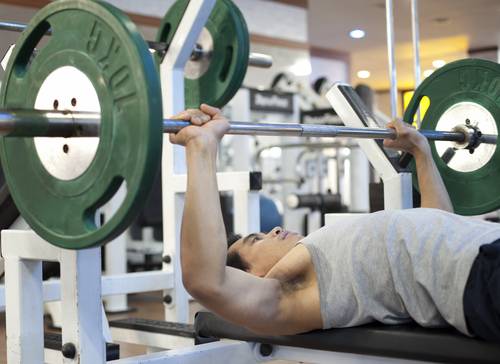Here we go again: another attempt to see if almost similar (sort of similar?) exercises and drills can transfer to specific sport skills and actually be effective. In this case it was a study performed in Finland with the objective to compare kinetics (study of mass motion relative to force exertion), kinematics (study of motion independent of mass or force exertion), and the extent of muscle activation in conjunction with a sprint block start, sled pulling, and various squatting and jumping exercises, namely countermovement jumps and one-half barbell squats with varied loads. In addition, the researchers sought to examine how the aforementioned exercises correlate with the performance time of the sprint block start over ten meters.
The volunteer subjects were nine male track and field athletes (four sprinters, three decathletes, one long jumper, and one triple jumper). Their averages were 24.9 years of age, 11.35 seconds in the 100 meters, and 11.8 years of experience in their events.
When the exercises were compared to the sprint block start over ten meters – in particular the force imparted on the blocks – these were the findings:
- In most exercises, the muscle activation in the gluteus maximus was significantly greater than the sprint block start.
- During the countermovement jumps and one-half squats (independent of load), ground reaction forces were greater.
- The angular velocity of the knee joint was significantly greater during the countermovement jumps than during the sprint block start.
Here’s where it becomes interesting and reveals why so many attempt to replicate specific sport skills with resisted or unabated exercises:
- In general, the kinematic values produced during countermovement jumps and sled pulling were more similar to values of the sprint block start.
- The greatest kinetic correlation was found between the time of the sprint block start over ten meters and the launch velocity during the bodyweight-only countermovement jump.
- The researchers concluded sled pulling and countermovement jumps can be effective training modes when training to improve the sprint block start due to similar (but not exact) velocity and movement specificity. Therefore, they rationalized a positive transfer could lead to improved ability in the sprint block start from those exercises.
It’s time to further dissect the results of this and offer reasonable applications. I’ve mentioned it before, but upon reviewing the proven facts on motor learning in general, specificity of skill execution, and transfer of skills, it comes down to this:
- Motor learning – The basic principles of skill development. Know them.
- Specificity of skill execution – Be exact, be precise, and never accept “almost.”
- Transfer of skills – Ask yourself, does performing similar activities better other activities?
The study in question served up some very practical take-home points:
 The more similar (but not exact) kinetic and kinematic expressions, the better the potential transfer. Potential is the key word here. Is it worth the time performing “almost” activities knowing there is some gray-area to those endeavors as compared to time spent on exact replication of needed skills, coupled with general muscle strengthening exercises that maximally target a greater amount of muscle tissue to fortify muscle quality?
The more similar (but not exact) kinetic and kinematic expressions, the better the potential transfer. Potential is the key word here. Is it worth the time performing “almost” activities knowing there is some gray-area to those endeavors as compared to time spent on exact replication of needed skills, coupled with general muscle strengthening exercises that maximally target a greater amount of muscle tissue to fortify muscle quality?
If there is the option to perform guaranteed safe and result-producing general strength training and conditioning exercises combined with exact skill practice or perform less-effective and potentially dangerous strength training and conditioning exercises also combined with practice on exact skill practice, which would be more logical?
The amount of time spent performing the less-than-100% specific but seemingly productive gray-area exercises should be questioned as compared to the goal of 100% exact specificity.
Remember, muscle strength (and concomitant power and endurance) should be developed generally so as not to interfere with specific sport-skill development. In separate sport-skill training sessions, aim for exactness and competition-dependent needs. Replicate what you’ll be required to do when it counts.
References:
1. Okkonen, O and K. Hakkinen, “Biomechanical Comparison Between Sprint Start, Sled Pulling, and Selected Squat-type Exercises,” Journal of Strength and Conditioning Research 27 (10): 2662–2673, 2013.
2. Rushall, B.S., and F.S. Pyke, Training for Sports and Fitness (Melbourne, Australia: Macmillan of Australia, 1991).
3. Schmidt, Richard A., Motor Learning and Performance: From Principles to Practice (Champaign, IL: Human Kinetics, 1991), 222.
4. DeBoer, R.W., G.J. Ettema, B.G. Faessen, B.G., H. Krekels, H. Hollander, G. De Groot, & G.I. Van Ingen Schenau, G.I., “Specific Characteristics of Speed Skating: Implications for Summer Training,” Medicine and Science in Sports and Exercise (19): 504-510, 1987.
5. Motor Control and Learning: The Basics of Skilled Instrumental Performance, accessed October 10, 2013.
Photos courtesy of Shutterstock.






